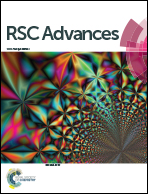Varying numbers and positions of carboxylate groups on Ru dyes for dye-sensitized solar cells: uptake on TiO2, cell performance and cell stability†
Abstract
Four simple ruthenium(II) dyes have been synthesised with the general formula [Ru(4,4′-(R,R1)-bipyridine)(4,4′-(R2,R3)-bipyridine)(NCS)2] where R, R1, R2 and R3 represent CH3 or CO2H, hence varying the number and position of the carboxylic acid groups that bind the dye to TiO2. The effect of varying the acid groups on cell fabrication, electrical performance and stability has been studied. The photophysical and electrochemical properties have been recorded and are relatively similar across the dye series, all showing parameters consistent with successful cell function, suggesting these dyes can be used as a good model to investigate the effect of changing the acid binding groups. Device measurements showed that the dyes containing a 4,4′-dicarboxy-bipyridine ligand, with two CO2H groups on the same bipy, gave higher short-circuit current than the dyes that had ligands with no more than one carboxylate group on a given bipy. Measurement of dye uptake on TiO2 using optical waveguide spectroscopy suggested that the dye with three acid groups provided better dye coverage, faster dye uptake rate, and a greater amount of dye remaining in the cell after rinsing. All four dyes gave cells that were broadly thermally stable at 85 °C over 500 hours, however the dye with only one acid group showed poorer thermal stability than the others.


 Please wait while we load your content...
Please wait while we load your content...